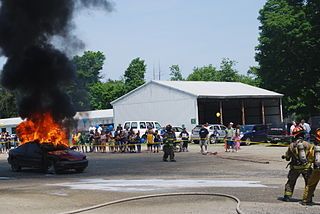Fire Burns Tesla Model S (!)

I’m reminded of one of the interviews I did on a visit for my first book, Renewable Energy – Facts and Fantasies, that I conducted at the office of Rick Sikes, fleet manager of the City of Santa Monica (California), which boasts 87% alternate fueled vehicles. When we wrapped up our conversation and went outside for a tour, I looked around at all the tanks of CNG, hydrogen, etc., and asked, mostly in jest, “Am I in any bodily danger?”
I could see immediately that Sikes wasn’t amused. He asked me if I knew how many cars per day burn up in gasoline fires. I apologized for my poor attempt at humor, and admitted that I had no idea. The answer, it turns out, is an average of six – a bit over 2000 per year – so many that they generally don’t even make the news.
In contrast, we can expect news of EV fires, when they occur, to gather huge headlines for many years to come.

Craig,
This is a non-issue on all sides… but comparing fires/MILES is a complete red herring. The accurate comparison is fires per high-speed collision, in which case EV’s don’t show anywhere near the same advantage over ICEV’s. The disconnect, obviously, is that other than the Tesla products most EV’s are never driven at high speeds, and hence are rarely involved in high speed collisions (only occurring when high-speed ICEV’s hit them).
Then factor in the fact that Tesla S’s are new, have good driving assist features (things like collision avoidance braking), and are usually treasured by their owners who do not drive them stupidly, and the number of high speed collisions drops further..
I don’t think you can sell EV’s as being “more fireproof” than ICEV’s, you can just note that the two types of vehicles are driven differently, and that your chance of your ICEV catching fire if you aren’t in a major collision is zero, which is the same as your chance of your EV catching fire if you aren’t in a major collision.
What makes this interesting is that prior to this, Musk was trying to sell the EV as something that was fireproof even if the EV was in a major collision… and that is clearly not entirely true.
Excellent points here. Thanks for the clarification. I suppose we should really conclude that no conclusion can be drawn at the point, as currently, EVs aren’t driven the same way ICEVs are.
Craig,
I don’t think we’ll have to wait long before we get some interesting data points here. I believe we’ll see a much lower instance of accidents with EV’s than we see with ICE’s in all categories… The same holds true for Prius class hybrid vehicles.
Whether or not EV’s are “green” (you know where I stand on that, there’s no reason to hash it out today), they are purchased by people who are concerned about responsibility. Those people generally are less likely to drive irresponsibly.
If there does seem to be a noteworthy correlation to “lower incident of accident” and “EV”, then you can bet the promoters like Musk will be broadcasting that data as loudly as possible – even if the correlation is between the likely EV purchaser and safety rather than the vehicle and safety… But that doesn’t take away the fact that some of the bells and whistles provided by the Tesla S (and other high-end vehicles) such as automatic collision avoidance breaking and lane assist alerts really do result in fewer accidents by virtue of the car itself.
That data here is going to be noisy, but it will be broadcast loudly as quickly as it becomes available.
😉
You’re right about the skewing of the data due to the different nature of the drivers. I don’t how this could ever be resolved.